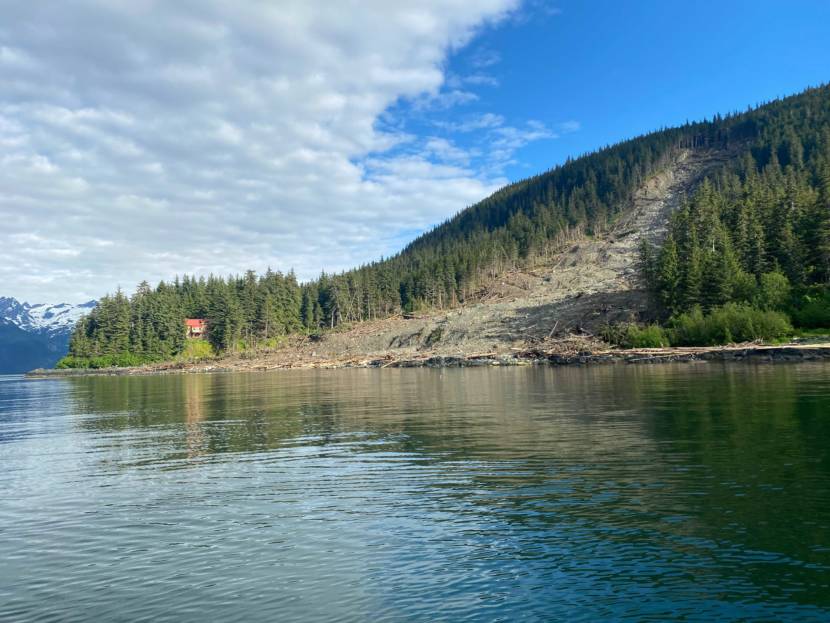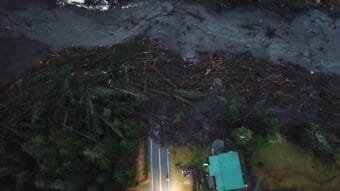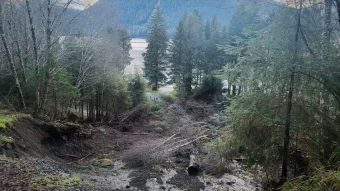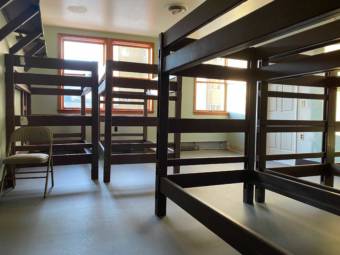
Congress recently passed legislation that will bring in millions of dollars for landslide research and mapping. State scientists are excited about the new program’s potential for Alaska, which needs more hazard maps. But that money isn’t headed toward communities that have had deadly landslides recently.
In the small town of Haines, it’s been eight months since landslides killed two people, destroyed nine homes, pulverized roads, and cut the town off from its fuel and supply docks. The community is still rebuilding after its losses.
“I feel honestly frozen. It’s like a frozen in time feeling,” said Vanessa Wishstar.
Wishtar and her family lived in a home next to the major slide that ran through Beach Road. Their home is intact, but it isn’t safe.
“The problem for us it wasn’t just like, okay, we’re now past the slide … There’s a giant crack still hanging looming above our house,” she said.
Geophysicists spotted a fissure in the mountainside above their home. They say the rock could give way and trigger another slide. But they won’t know the full extent of the risk for another year. The family of four has been in a small apartment since the disaster and is seeking a permanent solution.
“There’s literally no difference from when it happened to now. For us, you know, our life situation. I mean, if you look at it … nothing has really changed.”
The small town’s administration has been overwhelmed with work related to the disaster. Haines Mayor Douglas Olerud has been wading through paperwork to get what’s essentially buyout money for families that can’t return to homes in the danger zone.
“The borough’s on the hook for one to one and a half million dollars,” Olerud said. “Where do we come up with those funds?”
He estimates that’s the match to unlock millions in relief money to re-house displaced residents. But sourcing an extra million bucks is a big ask in a town that brings in about $5 million in taxes in a good year.
And Olerud says the relief money won’t come overnight — the victims’ rental assistance will dry up long before they know whether they qualify for the buyout money at all.
“They won’t know on a lot of this for three years if we’re going to be able to do mitigation program on it. And that’s the really hard part. How do you have somebody in limbo for that long?” he said.
There is landslide money on the way for Alaska, but it isn’t for Vanessa Wishstar or for Haines. This year, there’s $4 million in additional federal funds for national landslide research nationwide. But all of it is headed to Prince William Sound, where a potential landslide threatens to unleash a tsunami that could devastate Whittier.
Congress passed the Landslide Protection Act just a month after the slides. Alaska Sen. Lisa Murkowski co-sponsored the bill. It’s aimed at better understanding landslide risks and protecting communities like Haines.
De Anne Stevens heads the engineering section of the state’s Division of Geological and Geophysical Surveys.
“Everything is just, you know, screeching out of the starting zone with our race cars to try and get things taken care of and get to work on this. So it’s really exciting times,” Stevens said.
Her department is partnering with the U.S. Geological Survey for a three-year project that aims to create a statewide database for landslide information. Stevens says it’s work her department has long sought to tackle.
“Alaska is huge. We have so much that really has not been looked at, you know. We kind of have a little, tiny snapshot of what we think is going on out there. But I think it’s going to be really eye-opening when we actually get out there and start really systematically eyeballing the landscape,” she said.
But that database isn’t covering a lot of ground this year. And the new federal investment isn’t currently enough to map every possible landslide in Alaska. It’s not even close.
“Just so we’re clear, the landslide hazards department in the USGS is tiny,” said Jonathan Godt, the department’s coordinator. “You’re talking about, oh, two dozen scientists and technicians that are in many ways the federal capability in landslide hazard. And there are other agencies that add people and expertise, of course, but the only program with a focus on landslide hazards is in the USGS and it’s that size. And we got a doubling in resources from $4 million to $8 [million]. And that work was directed towards Alaska.”
Even though this year it’s all directed at Prince William Sound, Godt and state geologists both envision a sustained effort to address needs in other parts of the state.
State program officials say it will take a lot of money and many more years to do the kind of landslide assessment work the state needs.



